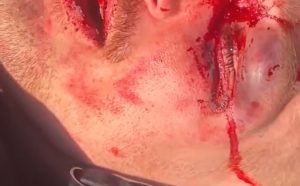Noticing that his site’s ALEXA rankings have plummeted by every single measure, Mike South, our favorite Georgia blogger, amateur pornographer, internet bully, defamer, liar, misogynist, escort outer and shamer, suspected embezzler, and failed talent agent (not to mention, coffee urn pisser) has once again weighed in on adult performer HIV testing for a few cheap clicks.
This is the man who, multiple performers have now confirmed, does not demand industry standard professional HIV tests on his sets — or indeed ANY tests for common STIs such as chlamydia or gonorrhea. Rather than employ a testing system, South jots down the results of in-home HIV testing kits in a spiral notebook, allows talent to “vouch” for people they bring to set, and uses his ESP and an interview process to determine whether his bukkake victims and mopes — some of whom may have been solicited on hobbyist boards — have had sex with any possibly infected person since he saw them last.
The irony of this criminally negligent asshole weighing in on performer health and safety issues and offering HIV testing advice is rich indeed. As if adult performers have been eagerly awaiting this cretin to issue his counsel.
His most recent semi-literate screed is as jumbled as usual. Immediately following a proclamation that “The ELISA with the Western Blot Combination [is] the “Gold Standard” Test for HIV” (more on this below), Uncle Bukkake tosses in this (unsourced) quote:
It is VERY IMPORTANT to note that the data here is for the 3rd generation Elisa test, almost all labs are now using a 4th generation Elisa test. A 4th Generation EIA (DUO) looks for both p24 antigen and HIV antibodies. what this means is that the window period is shortened to 1 to two weeks, the same as the Aptima test.
As fascinating as that is, 4th Generation testing has absolutely nothing to do with the Western Blot. Moreover, it is also not an ELISA test — it is a combination ELISA antibody and antigen test.
I have previously addressed the weaknesses of 4th generation testing here. (SPOILER ALERT: It’s inferior to the PCR testing currently employed by adult performer testing protocols.)
The hayseed blogger also includes this little anecdote:
HIV 2 is rare in the United States, but so was the HIV strain that Derren [sic] Roberts got infected with…if not for the Elisa test and some sharp people at the lab Darren would have gone undiagnosed for at least another month.
Now, I know the source for this gem (and, most likely, the unsourced quote) is the deranged laboratory account rep turned AHF snitch Tim Tritch (a.k.a. the man who sold out the AIM clinic), because Tritch told me the same story. What the moron blogger neglects to mention is this:
At the time of the Darren James case (2004) the test that was approved for use in clinical labs in the U.S. was the Roche Amplicor 1.0 test kit. However, even using the 1.0 test, HealthLine Laboratory detected something amiss in the result it received from James’ specimen.
At the time only research labs were using the more advanced Roche 1.5 test kit. It was due in part to AIM and HealthLine’s experience with the Darren James infection that the FDA approved the Roche 1.5 test kit in the United States. The Roche 1.5, which is currently in use, detects both strains. (Here is some reading on the Roche Amplicor http://www.ncbi.nlm.nih.gov/pmc/articles/PMC3111749/ from the National Institute of Health.)
ELISA
The imbecile blogger loves the cutting-edge 1980s technology of (inexpensive) ELISA antibody tests. He writes, “While much is being made of the ‘window period’ in porn circles it really is no longer the issue that it once was.”
LOL Oh really?
Here is information on the Oraquick in-home HIV test that the imbecile blogger has relied upon EXCLUSIVELY on his own sets (a.k.a. Atlanta area hotel rooms), direct from the product insert:
This test detects HIV infection if used 3 months after a risk event. If you want to be tested before 3 months, you should go to your doctor or local healthcare provider
Test Performance
In a clinical study, 4,999 people who were unaware of their HIV status were given the OraQuick® InHome HIV Test to take home and use. The researchers compared the OraQuick® InHome HIV Test results with laboratory test results performed by a trained professional. The laboratory based results show that a total of 96 people were HIV positive and 4,903 people were HIV negative. The comparison of results was as follows.
-
99.9% of people (4,902 out of 4,903) correctly reported a negative test result. The lab and OraQuick® InHome HIV Test found the same result. This means that 1 out of 4,903 people not infected with HIV reported a positive test result even though that person was really not infected with HIV. This is called a “false positive.”
-
91.7 % of HIV positive people (88 out of 96) tested reported a correct test result. This means that 8 out of 96 people who actually were infected with HIV reported a negative test result even though they had HIV. This is called a “false negative.”
-
In addition 1.1% of study subjects (56 out of 5,055) failed to obtain a test result.
To re-cap: the Oraquick test missed 8.3% of HIV infections. 8 people out of 96, who actually had HIV, were told they did not have HIV by the Oraquick test. More than 1% did not even get a usable result.
I repeat, this is from the manufacturer’s own documentation!
How do you feel about adult performers using a test that misses HIV infection or otherwise produces an inaccurate result nearly 10% of the time?
Here is the description of the Orasure rapid test (the cheap test that is used by the blogger’s heroes at AHF) directly from the manufacturer’s website:
-
OraSure mouth swab test is very accurate
-
OraSure is not as accurate as a blood test
- for example, it will miss finding 1 to 2 people with HIV out of 100 positive persons tested
-
as with blood tests, six to twelve weeks must pass after infection has occurred before enough antibodies have been produced for the test to detect them
-
an OraSure test performed three months after the potentially infectious event (sex without a condom or shared intravenous drug needles/equipment) is about 95% accurate
-
a test at 6 months will be the most accurate
-
The rapid result tests have proven to be highly accurate . . . on a par with or slightly more accurate than standard blood tests
-
all positive rapid result tests require us to draw a blood test as a confirming test
As you can see, Orasure is also an ELISA-type antibody test, with a demonstrated window period of three to six months. At six months it is most effective. It’s about 95% accurate at 90 days. A PCR test is 95% accurate at ten days.
Note the requirement of a blood test as a confirmatory test. This underscores the the differences in testing for the general public and adult industry testing.
As noted above, South wrote:
“The FDA has accepted The ELISA with the Western Blot Combination as the ‘Gold Standard’ Test for HIV.”
This hayseed, who is too cheap to pay for laboratory testing, seeks to the blur the difference between diagnosis and screening.
The FDA certifies or “approves” products for specific uses, while the CDC and state departments of health certify procedures or testing combinations as being adequate to diagnose a disease.
For example, here is the FDA’s list of approved tests for blood donors.
Note, the FDA does not say that all these tests are equally effective, just that these products have been approved to perform a certain task. Some are Cadillacs, others are Hyundais (or scooters, like South rides). The FDA does not endorse specific methods of patient care.
The purpose of testing of members of the general public is diagnosis (do they have HIV, and which test can we use to confirm their HIV status).
Adult performer testing is not designed to certify people as HIV-positive. The testing system is not the Department of Health. The purpose of the adult performer testing system is to provide early warning. It screens performers (or people attempting to enter the talent pool). This approach demands the most sensitive testing that can detect HIV as early as possible.
The imbecile blogger uses a chart from hivguidelines.org — which is produced by an office of New York’s Department of Health.
Being not only an idiot, but also a disingenuous sack of shit, he neglects to reference this page: http://www.hivguidelines.org/clinical-guidelines/adults/diagnostic-monitoring-and-resistance-laboratory-tests-for-hiv/
It discusses the use of antibody tests for diagnosis, and notes a distinction between patients who do or do not engage in “high-risk behaviors”. This is an acknowledgement that certain members of the population are more likely to contract HIV than your 80-year old grandmother.
Patients who test negative for HIV antibody at baseline should receive a follow-up HIV antibody test at 3 months. For individuals who test negative at 3 months but continue to engage in high-risk behavior, clinicians should discuss goal-oriented harm-reduction strategies, including referral for risk-reduction counseling services. Repeat testing at least every 3 months should be offered as long as high-risk behavior continues. (AIII)
Clinicians should evaluate the following populations for acute HIV infection, particularly when they present with a febrile, “flu”-, or “mono”-like illness that is not otherwise explained (see Diagnosis and Management of Acute HIV Infection):
-
Those who present for HIV testing (AIII)
-
Those who report a recent sexual or parenteral exposure with a known HIV-infected partner or a partner of unknown HIV serostatus in the past 2 to 6 weeks (AII)
-
Men who report having unsafe sexual practices with other men (AII)
-
Those who report needle-sharing (AII)
-
Those who present with a newly diagnosed sexually transmitted infection (AII)
-
Those who present with aseptic meningitis (AII)
-
Pregnant or breastfeeding patients (AIII)
Note, individuals who feel the need to show up to get tested are recommended to be evaluated for acute (new / recent) HIV infection. Adult performer testing is also designed to catch acute HIV infection.
Well, how should acute HIV infection be diagnosed? (Bear in mind, this all relates to determining an individual’s HIV status, not merely performing early warning screening.) According to the very same website cited by South:
When acute HIV infection is suspected:
- An HIV serologic screening test should be used in conjunction with a plasma HIV RNA assay (AII); the plasma RNA test should be performed even if the serologic screening test is negative (AIII); a fourth-generation HIV antigen/antibody combination test is the preferred serologic screening test if available
- Detection of HIV RNA or antigen in the absence of HIV antibody should be considered a preliminary positive result; HIV RNA testing from a new specimen should be repeated immediately to confirm the presence of HIV RNA
- Both serologic and RNA testing should be repeated to exclude a false-positive result when low-level quantitative results (<5,000 copies/mL) from an HIV RNA assay are reported in the absence of serologic evidence of HIV infection (AII)
HIV serologic testing should be repeated 2 to 3 weeks after diagnosis by HIV RNA testing to confirm infection. (AII)
No mention of a Western Blot or an ELISA.
Note, re-testing is required (for purposes of diagnosis) when the sensitive RNA test picks up a possible reactive result. Yes, the PCR-RNA test is very sensitive and sometimes yields a false positive result. That’s why PASS protocols require retesting whenever a performer’s test yields a preliminary positive “reactive” result. But which would you rather have — a sensitive test that sometimes throws a false positive, or a more specific test that may not catch early acute HIV as reliably? I know that I’d go for the more sensitive test.
“[T]he plasma RNA test should be performed even if the serologic screening test is negative.” Gee, why would that be? because it’s the most sensitive. As discussed at length here, PCR-RNA testing, which is employed under the adult business’ PASS testing protocols, is the most accurate way to detect an acute HIV infection.
Lastly, South revives his claim that people who had been declared HIV-positive but are on anti-viral meds would test negative on PCR testing. Naturally, he cites no scientific source for this claim. Therefore, I’ll give South’s own source, Tim Tritch, the last word.
From an email to me, Mach 18, 2012
“[T]he notion that an HIV+ person on meds would test negative on the PCR is laughable. HIV+ people constantly have PCR tests done to measure their viral load as part of their routine treatment.”








Thank you for printing this. Not about Mike South per se- but about HIV testing. I admit I lost so many people during the 1980’s to HIV that I pretty much walked away from the whole field after I saw AIM open. I figured she was pretty much taking care of the porn industry – and I saw other cities having outreach to sex workers for HIV – so I assumed our “job was done”. I was wrong. Now I’m seeing cops using condoms as “evidence of prostitution” again as well as testing sites thinking that homeless women are the… Read more »
I respect your guys’ open policy on commenting, but maybe you could consider moderating this wacko…
Nuthin says “crazy” like a gigantic wall of text.
tl/dr
Or multiple walls of text…